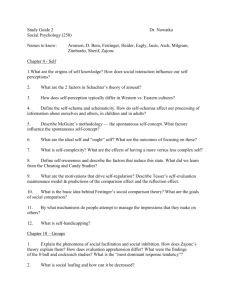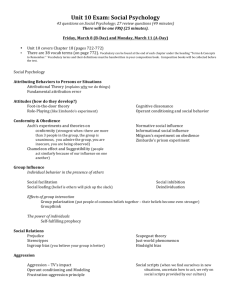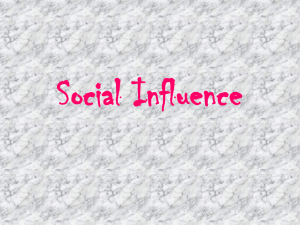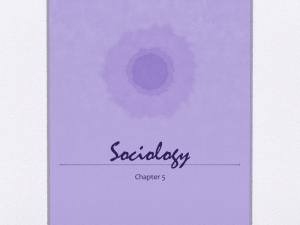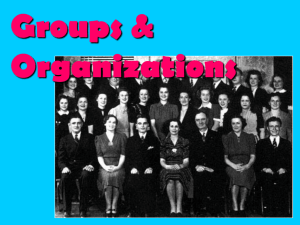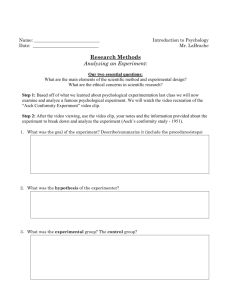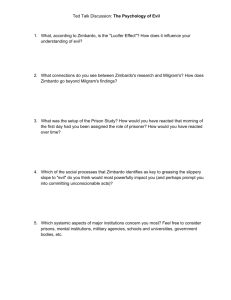File - Francis Social Studies
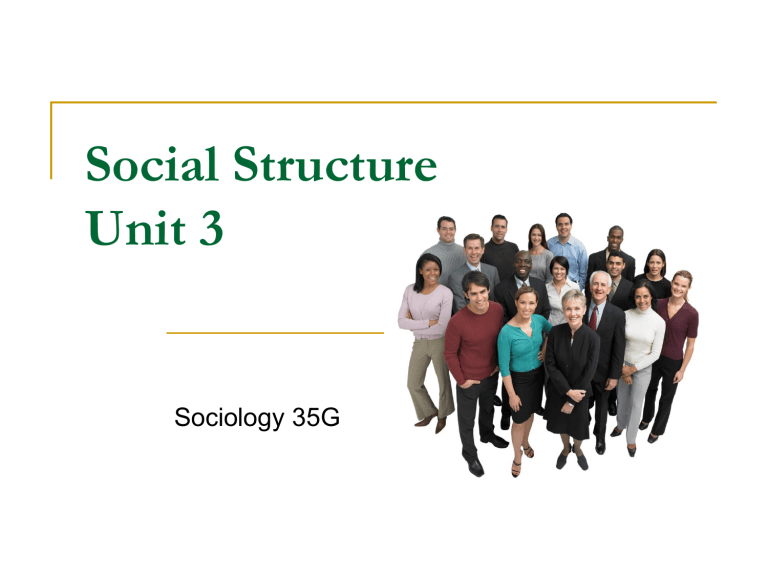
Social Structure
Unit 3
Sociology 35G
Social Structure and Status
Social Structure
The underlying patterns of relationships in a group
Status
A position a person occupies within a social structure
Ascribed Status
A position that is neither earned nor chosen but assigned
Achieved Status
A position that is earned or chosen
Social Structure and Status
Status Set
All of the statuses that a person occupies at any particular time
Master Status
A position that strongly affects most other aspects of a person’s life
My Status Set
Write down all the statuses that you occupy at this point in your life.
Beside each status, write down which ones are ascribed and which ones are achieved
Now decide which one or ones are your master statuses…these can be achieved or ascribed
Explain why these are your master statuses!
Philip Zimbardo’s Prison Experiment
Role Playing
Social Psychologist Philip
Zimbardo designed an experiment to observe the behaviour of people in a mock prison.
Philip Zimbardo’s Prison Experiment
This is one of the most famous and controversial studies ever conducted in the field of social science.
Philip Zimbardo’s study is a classic example of the power of the situation and how easily an individual can slip into a role and have it become real.
Zimbardo Prison Experiment
Exit Slip
Write a reflection (your thoughts, wonderings) about the Zimbardo Experiment.
Give an example in your life, either recently or when you were a child, when you were put in a role where you acted in a way that you would not normally act.
Social Structure and Roles
Role
An expected behaviour associated with a particular status
Right
A behaviour that individuals can expect from others
Obligation
A behaviour that individuals are expected to perform toward others
Role Performance
The actual behaviour of an individual in a role
Social Structure and Roles
Role Conflict
Condition in which the performance of a role in one status interferes with the performance of a role in another status
Role Strain
Condition in which the roles of a single status are inconsistent or conflicting
Role Conflict or Role Strain?
Mr. Jones is a member of a high school board and his daughter is in Grade 11 at the same school. The board recently considered a proposal to drastically cut spending in the art department. Mr Jones’ daughter is an aspiring artist with dreams of opening her own studio someday. Mr. Jones’ vote could be crucial. What should Mr. Jones do?
Role Strain and Role Conflict Activity
In your group act out a scenario of role strain or role conflict.
Examples:
Role strain at school
Role conflict at school
Role strain within the family
Role conflict within the family
Role strain in social life
Role conflict in social life
Exit Slip:
Role Strain or Role Conflict
Think of a time when you encountered either role strain or role conflict. Explain what happened and how you felt.
Groups
Groups are classified by how they develop and function.
Social Category
People who share a social characteristic
Social Aggregate
People temporarily in the same place at the same time.
Primary Group
People who are:
1.
2.
3.
emotionally close, know one another well, and seek one another’s company.
Secondary Group
People who share only part of their lives while focusing on a goal or task.
Primary or Secondary Relationships?
3.
4.
1.
2.
A married couple
A coach and her soccer team
A teacher and her students
A car salesperson and her potential customer
Primary Relationships involve interactions that are intimate, personal, caring and fulfilling.
Secondary relationships involve impersonal interactions involving limited parts of personalities
Activity
Identify a primary group and a secondary group to which you belong.
Describe three functions of each of these groups based on your personal experiences
The Lifeboat Game
A passenger liner is wrecked at sea and these
15 people find themselves together in a lifeboat. The lifeboat however, can only support 9 people. If six are not eliminated everyone will die. If you were in command of the lifeboat, whom would you choose to survive?
The Lifeboat Game
In your assigned secondary groups , you are required to reach a joint decision to which passengers will be eliminated.
Exit Slip #6 Lifeboat Activity
Was this a difficult task for you to do in your secondary group? Explain why.
If you had done this activity on your own would your answers have been different? Explain why.
If you had done this activity with one of your primary groups, would your answers have been different?
Explain why.
Social Interaction
Cooperation
Interaction in which individuals or groups combine their efforts to reach a goal
Conflict
Interaction aimed at defeating an opponent
Ingroups and Outgroups
The social definition of who you are also implies who you are not
Two kinds of groups that provide us with standards against which we evaluate ourselves. People tend to perceive certain groups as more attractive to belong to than others.
Social Interaction
Social Exchange
A voluntary action performed in the expectation of getting a reward in return
Coercion
Interaction in which individuals or groups are forced to behave in a particular way. The opposite of social exchange. Coercion is a one way street. (e.g. Parents coerce children with a curfew, guards coerce prisoners with force and governments coerce drivers with fines.)
Conformity
Behaviour that matches group expectations. Without conformity there would be no culture or social structure.
Social Interaction
Group Think
Self-deceptive thinking that is based on conformity to group beliefs, and created by group pressure to conform
Group Think
Many decisions are likely to be the product of groupthink.
For example:
During the administration of President John F.
Kennedy in the early 1960s, for example, the president and his advisers decided to launch an invasion of Cuba at the Bay of Pigs. The invasion failed. Analysis revealed that during the decision process, because of group pressure, several top advisers failed to admit that they thought the plan would probably not succeed.
Solomon Asch’s Experiment
In 1951 social psychologist
Solomon Asch devised an experiment to examine the extent to which pressure from other people could affect one's perceptions.
In total, about one third of the subjects who were placed in this situation went along with majority’s wrong opinion.
Conditions that Strengthen Conformity
3.
4.
5.
1.
2.
The person feels insecure.
The group has at least 3 people.
The group is unanimous.
The person admires the groups’ status.
Others in the group are observing the person’s behaviour.
Exit Slip #7
Conformity
Think of a time when you conformed to a group that went against what you would normally do or think.
Explain the situation and why you think you conformed to the people in this group
Stanley Milgram’s Experiment
Stanley Milgram, a psychologist at Yale
University, conducted a social psychology experiment that focused on the conflict between obedience to authority and personal conscience
Milgram came up with a famous and controversial experiment to examine what happens when ordinary people are faced with morally questionable orders. What he learned shocked not only him but the entire world.
He tested whether people would shock a person simply because an authority figure told them to do it.
In the experiment, conducted at Yale University over a period of months in 1961, an authority figure -- "the experimenter" -- dressed in a white lab coat and instructed participants to administer what they believed were increasingly painful electric shocks to another person.
Two-thirds of Milgram's participants delivered shocks as they heard cries of pain, signs of heart trouble.
http://abcnews.go.com/Video/playerIndex?id=2769000
Stanley Milgram’s Experiment
Conditions that Strengthen Obedience
1.
The person giving the orders is perceived as an authority figure is close at hand.
2.
The victim is depersonalized or at a distance from the person obeying
3.
There were no role models for defiance (no one else is disobeying)
Video: Group Influence
What surprised you about the video
What are some of the things you learned about group influence
5 Types of Group Social Interaction
Read pages 181-185
Write a definition for each term and then give a personal example of the 5 types of social interaction:
1.
2.
3.
4.
5.
Cooperation
Conflict
Social Exchange
Coercion
Conformity
Cooperation, Conflict, Social Exchange,
Coercion or Conformity
1.
2.
3.
Blood donors expect payment.
Social exchange
Students read what a teacher assigns. conformity
Saddam Hussein invades Kuwait. conflict
4.
5.
Flood victims help each other. cooperation
Employees are forced to work overtime or be fired coercion
Why is conformity essential for the development of social structures?
Social Psychologists:
Philip Zimbardo – Role Playing
Prison Experiment
Solomon Asch – Conformity
Line Experiment
Stanley Milgram – Obedience
Shocking Experiment
Leadership in Groups
A leader is someone who is consistently able to influence the behaviour of others.
Instrumental leadership organizes a group by defining goals and determines ways to achieve them
Expressive leadership creates harmony and keeps morale high usually well liked by group members
Leadership Styles
Authoritarian
Give orders
Effective in emergencies
Democratic
Attempt to win consensus on goals and courses of action
Concern for individual rights in the group
Laissez-faire
Make little attempt to direct or organize the group
Group functions mostly on its own
Cliques
Clique – an exclusive group that includes a small number of chosen members
Why do people belong to cliques?
Through cliques, people find others who share their values, ideas and activities.
Cliques provide a way to form close friendships.
Activities:
1. Reading 6 “The Curse of Cliques” and
2. Primary group analysis:cliques Alternative assessments pg 30
Cliques Exit Slip #8
What clique do you feel you belong to at
Vincent Massey? Describe your clique
(norms, behaviours, activities, appearance)
How does this clique make you feel?
How did you feel about the group activity we did? Why? Were you offended by any comments?
Castlegate: Group Brain Teaser
How effective was your group in this activity?
Was there a lot of discussion in your group?
If not, why?
Did someone act as a leader in your group?
Was this helpful or not?
Do you usually act as a leader in group activities? Are you comfortable acting in a leadership role? Why or why not.
Individual Activity “Groups”
Consider your own family . Analyze how you are a part of that social group. Ask yourself the following and write down the answers.
Hand in your answers when finished…today!
1. What am I expected to do and be in that group?
2. What is my position or status in that group?
3. In what ways am I an important part of the group?
4. What happens when a family member does something the rest of the group doesn’t like?
Formal Organizations and Bureaucracies
Formal Organization – a group deliberately created to achieve one or more long term goals
Bureaucracy – a formal organization based on rationality and efficiency
Unit 3 Test
Social Structure
Status
Ascribed Status
Achieved Status
Status Set
Master Status
Role
Right
Obligation
Role Performance
Role Conflict
Role Strain
Social Structure
Social Aggregate
Social Category
Primary Group
Secondary Group
Ingroups and Outgroups
5 Types of Social Interaction:
Cooperation
Conflict
Social Exchange
Coercion
Conformity
Group Think
Cliques
Types of Leadership
Leadership styles
Long Answer Questions:
The Social Psychologists and their experiments:
Stanley Milgram, Philip Zimbardo and Solomon Asch
